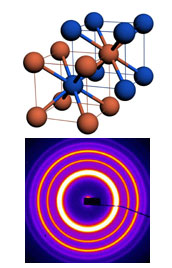| Posted: February 12, 2008 |
DNA the link in nanoparticle construction |
|
(Nanowerk News) Generating novel materials with new functions to order by the controlled assembly of different nanosized building blocks is a tantalizing prospect for nanotechnology. Yet achieving it is far from straightforward.
|
|
DNA would appear to be the best option for guiding the assembly of the nanoparticle bricks into the desired construction. DNA strands can be attached to the nanoparticles, with sequences programmed to zip up with complementary DNA strands on a neighboring particle.
|
|
But previous efforts at building in three dimensions have most often yielded amorphous aggregates.
|
|
Now two independent groups have systematically studied the requirements for the DNA strands, and successfully directed Au nanoparticles to form three-dimensional crystals.
|
 |
| Schematic of a body-centered cubic crystal of gold nanoparticles connected by two complementary strands of DNA. The small-angle X-ray scattering pattern confirms the crystallinity of the assembly. (Image: Oleg Gang, BNL.)
|
|
Chad A. Mirkin and colleagues at Northwestern University and Argonne National Laboratory have used DNA sequences to guide 15 nm diameter Au nanoparticles to crystallize in different structures ("DNA-programmable nanoparticle crystallization").
|
|
The researchers coated all the Au nanoparticles with multiple copies of the same single-stranded DNA molecule. Complementary DNA linkers are then added to connect the nanoparticles together. The mixture is heated above the melting temperature of the DNA complexes and allowed to cool slowly, letting the nanoparticle crystals form.
|
|
Using a single DNA linker sequence results in a close-packed, face-centered cubic crystal structure. But using two different linker sequences that bind to each other but not themselves gives a binary system, which crystallizes in an open, body-centered cubic structure.
|
|
“We are now closer to the dream of learning, as nanoscientists, how to break everything down into fundamental building blocks and reassemble them into whatever structure we want,” says Mirkin.
|
|
Using a similar method, researchers at Brookhaven National Laboratory (BNL) have further investigated the interactions between complementary DNA-functionalized nanoparticles ("DNA-guided crystallization of colloidal nanoparticles").
|
|
They find that the length of the DNA linkers is key, with longer spacers allowing sufficient flexibility for the nanoparticle systems to crystallize. Their body-centered cubic crystals are remarkably open, with ~90% of the volume occupied by solvent (as shown).
|
|
“The ability to engineer such three-dimensional structures is essential to producing functional materials that take advantage of the unique properties that may exist at the nanoscale – enhanced magnetism, improved catalytic activity, or new optical properties,” says lead author Oleg Gang.
|
|
Christopher B. Murray of the University of Pennsylvania is convinced that these are important contributions in the directed assembly of nanomaterials. “Each research group has demonstrated how the best of molecular recognition in DNA tagging can be combined with optimized packing of the particles to make robust assemblies.”
|

